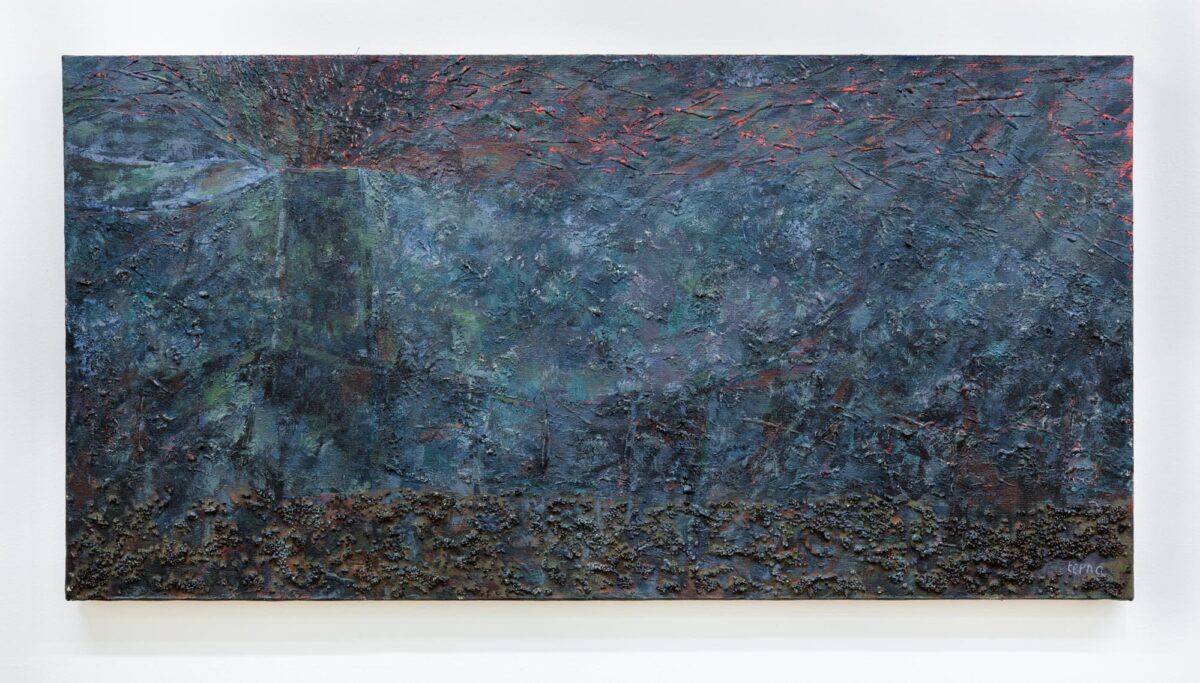The Museum community mourns the loss of Frederick Terna, an artist, scholar, Holocaust survivor, and longtime member of the Museum’s Speakers Bureau. Fred died on December 8, 2022 at the age of 99.
Fred’s contributions to Holocaust memory and education are indelible. He was a prolific artist who often incorporated into his artwork religious themes and elements of his story of survival during the Holocaust, a process he continued well until the end of his life. Fred was the very embodiment of his favorite quote that he shared in an interview with the Jewish Telegraphic Agency: -“”It’s more important to become tradition than to have a tradition.””
Fred was born on October 8, 1923 in Vienna, Austria, moving shortly thereafter to his family’s home in Prague. Fred remarked that he had an excellent education in Prague, one that came to a halt when he was expelled at age 15 when the Nazis invaded in March 1939. In response to the increasing danger, his father arranged for Fred to live in hiding from 1939 to 1941 under an assumed identity on a farm outside of the city. Beginning in October 1941, Fred was imprisoned in a number of camps, including Theresienstadt, Auschwitz-Birkenau, and Kaufering, a sub-camp of Dachau, from which he and his friend Tommy attempted an escape. He identified himself as an artist from the time he was imprisoned in Theresienstadt, having been exposed to its rich artistic landscape. It was there that he was witness to the famous Verdi’s Requiem performance led by Rafael Schächter. Fred later reflected:
“As early as 1943, while still in Theresienstadt, I decided that I wanted to become a painter. In 1945, after liberation, then still hospitalized, a friendly soul gave me watercolors and I painted scenes remembering Auschwitz and other places. I quickly realized that part of me was still in the camps, and I changed to painting landscapes. Much later, looking at some of my landscapes I noticed that there were walls and fences in many of them. It taught me that the memory of the Shoah was a part of me, and that it would not go away, and that I would have to live with it.”
He was liberated near Landsberg in Bavaria on April 27, 1945. He was the only surviving member of his family. As Fred described it, “The number of relatives who perished depends on the width of the circle drawn.” After liberation, Fred returned to Prague and later settled with his wife Stella in Paris for several years, where he pursued his dream of becoming an artist and “informally studied at the Académie de la Grande Chaumiere and the Académie Julien, where he was inspired by the work of the Cubists and post-Impressionists.” In 1952, he arrived in New York. As an artist and painter, he served as president of the Jewish Visual Artists Association from 1978-1981. Besides speaking about his wartime experiences, he lectured extensively on the history of Jewish art, and taught a course on the subject for some years at the New School in New York.
Dozens of galleries and museums have exhibited Fred’s artwork, including the United States Holocaust Memorial Museum, the Smithsonian, The Ghetto Fighters Museum, Yad Vashem, St. Francis College, and many others. You can learn more about Fred’s extensive body of work here: https://frederickterna.com/about


Fred was a member of the Speakers Bureau at the Museum of Jewish Heritage – A Living Memorial to the Holocaust since it opened in 1997, where he spoke to thousands of students and teachers. His last speaking engagement at the Museum was in December 2021 at the dedication of the Children’s Tree. In January 1943, a Jewish teacher imprisoned in Terezín planted a silver maple tree and nurtured it along with a group of Jewish children, who used their precious water rations to help it grow. 78 years later at the planting of that tree’s descendant, Fred remarked in this dedication ceremony:
“I want to thank you for remembering Terezín, remembering the children. I remember one thing I wanted; What is it that made us persevere instinctively?: The community of Terezín was a civilized and moral community. And this is what I think would help me; that is, [being] aware that there is such a thing as human behavior. This is what keeps me going to this moment, and I want to thank you [for keeping the] memory alive. That is, you’re doing the one thing that we try to remember and do the right thing. Thank you for being here and being part of the memory that you are trying to keep alive. We were are form of a civilization that went on while around us there was death and destruction. Thank you for being a part of that memory.”
When asked how to respond to injustices of the current moment, Fred always said in his succinct, matter-of-fact way, “Be involved.”
Fred is survived by his wife, Dr. Rebecca Shiffman, his son Daniel, and his daughter-in-law Tara. May Fred’s memory be for a blessing.
You can watch Fred’s testimony here: https://www.youtube.com/watch?v=KaV78vxG7oU
